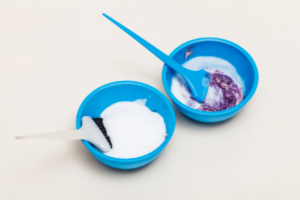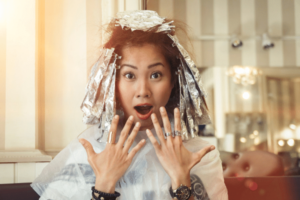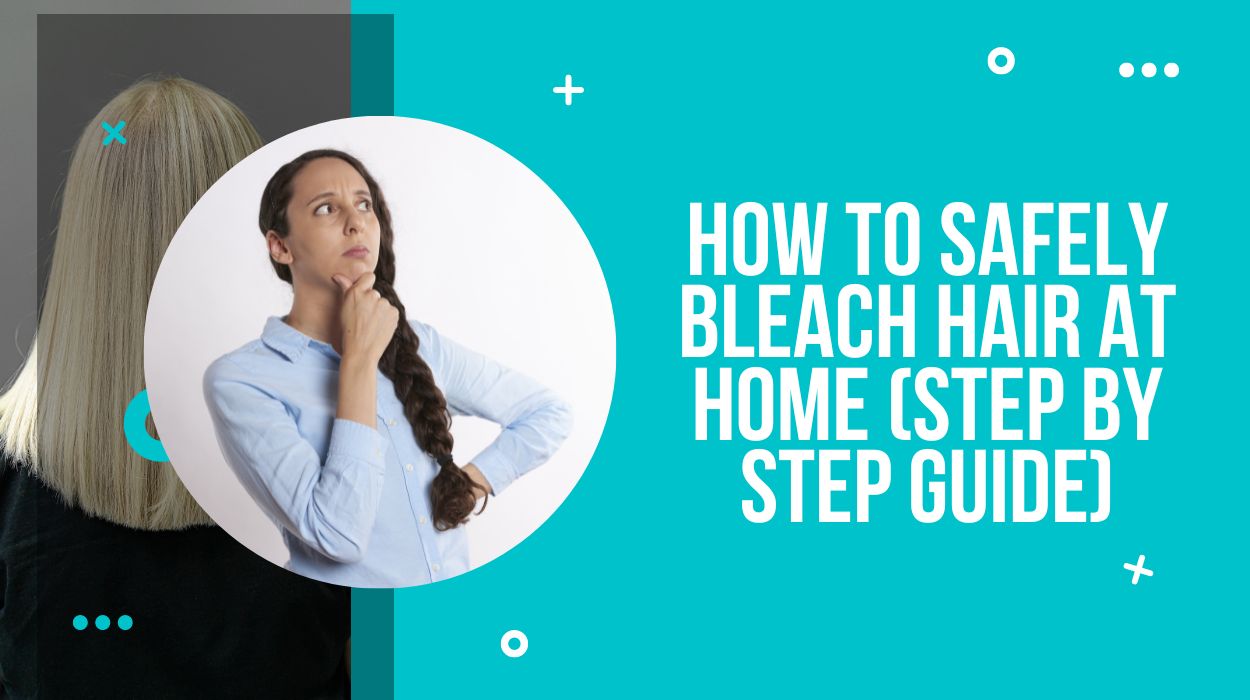Can you bleach your hair at home? Is that possible? Of course, yes. Basically, bleaching strips the original colour out of your hair strands by making them lighter. However, Bleach is an in-depth process, and therefore it is time-consuming.
It also has side effects and may not suit you. But you can try bleach on hair at home safely. How? Read the whole article to know!
This article will talk about the method to bleach your hair at home, its side effects, all preparations you need to do before bleaching, and when you shouldn’t bleach your hair.
Bleach

Bleaching your hair is a chemical dye technique using an oxidizing agent. The longer you keep the chemical in your hair, the more hair colour lightens. If you have coloured hair, it is good to wait for at least 8 to 10 weeks before bleaching because it may damage your hair.
Bleach works best on virgin hair, and if you already have processed your hair once, wait for at least three months before bleaching. Even after straightening treatments, avoid it for a few months.
You might be afraid of the side effects of bleach if not applied correctly, and obviously, you can not trust anybody for that. So, let us see how you can apply bleach at home rather than at a salon.
How to apply bleach on hair at home?

The foremost step is the preparation before applying bleach to hair. You know that there are many reasons for bleach to damage your hair. Therefore, do not risk and keep your hair healthy before starting the process.
But, how will you keep it healthy? Bleach penetrates deep into the shafts, and if your roots have lost their moisture, then bleach can completely damage your hair and scalp. To avoid it, you can
- Stop using electric devices to curl, straighten or roll your hair before bleaching.
- Use sulphate and alcohol-free shampoos and products.
- You can apply homemade hair conditioners twice a week before bleach.
- Apply an oil overnight before applying bleach in the morning.
- And as mentioned above, avoid not processing or colouring your hair at least three months before bleach.
These all will help maintain the moisture in the hair follicle preventing damages.
1. Wear cloth and gloves
Cover yourself with an old cloth and wear gloves to start the process. Why? To not get your arms and legs bleached. The bleach mixture may drop on your hands, and with scalp hair lightening, you may also lighten the colour of unwanted hairs on your arms.
2. Prepare your hair
Neither wash your hair with shampoo nor wet it before bleaching. Why? Because the chemicals present in the mixture that you will apply on the roots may give you a burning sensation or sizzle the cracks on the scalp.
So, always keep your hair dry and do not bleach right after shampooing.
3. Divide into sections
Divide your hairs into sections and use pins or clutches. Sectioning will help avoid damage and side effects to your scalp. And also, you will be able to apply bleach to all the parts, including the hairs at the back that are usually unreachable.
First, divide your hair from the middle until your hair ends. Then divide the parts again into two sections. Clip all four of them and start applying bleach on the sections one by one.
4. Prepare the bleach
To prepare a bleach, you must mix the bleach powder and developer/peroxide. What should be the quantity of both? Mix 1 part of bleach powder to 2 parts of the developer to get a smooth paste.
Buy a good brand of bleach powder and avoid using face bleach.
Developer or peroxide is a creamy product having hydrogen peroxide. It is added to bleach powder to lighten or change your hair colour. You can get a developer in different volumes, 10, 20, 30 and 40.
These volumes tell you how dark the colour will leave on your hair. Vol 10 gives you the lightest pale blonde colour, Vol 20 darker than Vol 10.
And in Vol 30, the concentration of hydrogen peroxide increases and gives your hair dark colour, because of which you cannot apply it on your scalp and have to keep it away from your skin to avoid any damage. I hope it’s clear to you that the concentration level of the developer with Vol 40.
Tip: Do not keep it for a longer period on your hair to dry.
5. Apply the bleach mix
Start applying the runny mix of bleach to your hair in the mid-section. Then to the ends and at last on the roots. Roots at the end because you don’t have to keep the bleach for long to dry on your scalp to avoid side effects.
When you apply it, your hair swells up to let the bleach affect your inner part of the strand by removing the natural hair colour from each strand.
Cover your hair with a shower cap or plastic bag as soon as you complete applying the bleach to all the sections. Let the bleach mix dry and bring changes to your hair.
6. Wash hair
Wash your hair after 40 to 45 minutes or as soon as the bleach dries. Rinse off the bleach using shampoo. Now, which shampoo to use so as not to affect the hair bleach? Purple shampoo and conditioner is the best option as it neutralizes the colour.
Purple shampoo is like a toner consisting of purple pigments that neutralize the hair colour and keep it not turning orange or brassy.
Advice: Do not use purple shampoo otherwise because it may make your hair dry.
7. Haircare
To maintain the effectiveness of bleach, you must take good care of your hair. Bleaching makes your hair dry and weak. And, to avoid breakages and dryness, it is essential to keep your hair hydrated all time. What can you do?
- Try to use more natural and homemade products for your hair. The chemicals may damage and reduce the effect of bleach.
- Do not use flat irons, curlers, or any other electronic or heating device on your hair.
- Oil your hair to keep your scalp moisturized. You can even apply homemade hair masks to protect it from damage.
- Avoid using conditioners to prevent breakages until your hair regains its natural strength.
- If you want to use shampoo, then dilute it to lessen the effect of chemicals on bleached hair.
Side effects

Bleaching of hair is itself a side-effect of a chemical in it, as you are losing your natural hair colour. Bleach has an alkaline agent that opens up your hair cuticles and an oxidizing agent that penetrates the hair cortex to dissolve the natural melanin.
The longer you keep the bleach paste applied to your hair, the lighter the colour you get.
Let us see the other side effects.
- Bleach breaks down the protein in your hair to give the required colour.
- After bleaching, your hair gets weaker than before.
- Bleaching increases the chances of hair breakages.
- It may increase the frizziness of your hair.
- Bleach increases dryness.
- If you do not use the bleach correctly or have sensitive skin, you might experience burns on the scalp.
- Also, bleach can cause skin irritation.
- The damages caused by bleach may be visible.
You May Also Like To Read:
How To Get Smooth Hair At Home?
Easy Ways To Increase Hair Density
How To Increase Melanin In Hair?
Conclusion
Bleaching does have side effects, but you can use it safely at home and take proper hair care after bleaching. To apply bleach on your hair, first, you must cover yourself and then mix bleach by adding 1 part bleach powder to 2 part developer.
Do not forget to apply the runny bleach mix to your hair by dividing your hair into sections to get the best results. And at last, wash your hair with purple shampoo or conditioner to neutralize the colour.
We hope you got all the information you were looking for, and now you can easily apply bleach at home, avoiding most of the side effects. Do share your experience of bleaching your hair at home in the comment section below.


